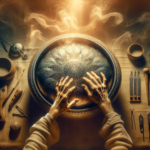Handpans are enchanting instruments that have rapidly gained a global following since their inception in the early 2000s. These otherworldly-sounding instruments belong to the idiophone class of instruments, where sound is produced primarily by the vibration of the material itself, without the use of strings or membranes. The handpan’s unique, ethereal tones have captivated both musicians and listeners alike, making it a beloved addition to the world of percussive soundscapes.
Origins and Evolution
The story of the handpan can be traced back to the year 2000, when Felix Rohner and Sabina Schärer, founders of PANArt in Switzerland, invented the Hang. Inspired by the steelpan from Trinidad and the Udu from Africa, the duo sought to create an instrument that captured the best of both sonic worlds. Through extensive experimentation with metal tuning and shaping, they eventually developed the Hang, the first handpan, characterized by its domed shape and precisely tuned note fields.
The Hang was released in limited quantities, and its mesmerizing sound caught the attention of musicians worldwide. Despite its growing popularity, PANArt ceased production of the Hang in 2013, leading to the rise of other handpan makers. Today, numerous artisans around the globe create their own versions of handpans, each contributing to the instrument’s evolving design and sound.
Design and Structure
Handpans are generally made from two hemispheres of steel or other metal alloys, shaped and tuned to produce specific musical notes. The top shell, or “Ding” side, features a central note surrounded by a circle of additional notes, each with its own tone field. The bottom shell, or “Gu” side, often has a resonant hole that can be muted or modulated to create different acoustic effects.
The tuning process is a meticulous art that requires both skill and precision. Handpan makers use hammers, anvils, and electronic tuners to shape and tune each note field accurately. The notes are typically arranged in a diatonic or pentatonic scale, although some handpans utilize exotic or custom scales to achieve unique soundscapes. The resonance and sustain of each note depend on the metal’s properties and the tuning technique employed, giving each handpan its distinct voice.
Playing Techniques
Playing the handpan involves striking the note fields with the hands or fingers, rather than using sticks or mallets. This approach allows for a more intimate and expressive interaction with the instrument. Players can create a wide range of sounds by varying the pressure, speed, and angle of their strikes. Techniques such as tapping, sliding, and muting add further layers of complexity and nuance to the performance.
Handpans are played by both novices and seasoned musicians, each finding their own ways to explore the instrument’s capabilities. The intuitive layout of the note fields enables spontaneous and improvisational playing, making it accessible for those without formal musical training. Meanwhile, experienced players can delve into advanced techniques and complex compositions, pushing the boundaries of what the handpan can achieve.
Cultural Impact and Popularity
Since their introduction, handpans have made significant cultural inroads, influencing various genres of music and appearing in diverse contexts. They are often featured in ambient, world, and fusion music, where their ethereal tones provide a captivating backdrop. Handpans have also made their way into meditation and therapeutic practices, where their soothing sounds aid in relaxation and mindfulness.
Social media and online video platforms have played a crucial role in the handpan’s rise in popularity. Videos of handpan performances often go viral, attracting millions of views and inspiring new players to join the community. Music festivals, workshops, and gatherings dedicated to the handpan further foster a sense of community and shared passion among enthusiasts.
Challenges and Future Prospects
While handpans are beloved for their unique sound, their production presents several challenges. The meticulous crafting and tuning process are time-consuming and labor-intensive, resulting in limited availability and high prices. The demand often far exceeds the supply, leading to long waitlists and challenges in acquiring an instrument.
Despite these challenges, the handpan community continues to grow and evolve. Advances in materials, tuning techniques, and manufacturing processes are gradually addressing some of these issues, making handpans more accessible to a broader audience. Innovations such as hybrid handpans, integrating electronic and acoustic elements, are also expanding the instrument’s possibilities, paving the way for new musical explorations.
Conclusion
Handpans represent a remarkable fusion of craftsmanship, musicality, and cultural innovation. Their enchanting sound and versatile playing techniques have earned them a special place in the world of percussive soundscapes. As both an artistic and meditative tool, the handpan continues to captivate and inspire musicians and listeners alike. With ongoing advancements and a dedicated global community, the future of handpans promises even more exciting developments and creative possibilities.
FAQs
1. What is the difference between a handpan and a Hang?
The Hang is the original instrument created by PANArt, which is one specific type of handpan. The term “handpan” is now used more broadly to refer to similar instruments produced by various makers worldwide. Essentially, all Hangs are handpans, but not all handpans are Hangs.
2. How are handpans tuned?
Handpans are tuned through a precise and labor-intensive process involving the shaping of the metal with hammers and anvils to achieve the desired pitch for each note field. This process often includes the use of electronic tuners to ensure accuracy.
3. Can anyone learn to play the handpan?
Yes, the handpan is accessible to players of all skill levels. Its intuitive design allows beginners to produce pleasant sounds relatively quickly, while experienced musicians can explore more advanced techniques and compositions.
4. Why are handpans so expensive?
The high cost of handpans is largely due to their complex and time-consuming crafting process. Quality handpans are made by skilled artisans who meticulously shape and tune the instrument, resulting in limited production numbers and higher prices.
5. What are some tips for choosing a handpan?
When choosing a handpan, consider the scale and tuning, as these will affect the instrument’s sound and compatibility with your musical preferences. Additionally, research the maker’s reputation for quality and craftsmanship, and be prepared for potential wait times due to high demand.





